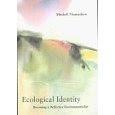
It's both rewarding and inspiring to observe all of the renewed interest in sustainability, especially in higher education. However, it's crucial that in uncertain economic times, we reiterate our commitment to sustainable approaches to all aspects of our lives.
Let's remember that sustainability is a response to three extraordinary and interconnected challenges—biodiversity loss, species extinction, and climate change. This response entails more than LEED buildings, innovative technologies, and cool new courses. It involves all aspects of organizational life, including values, governance, learning, and infrastructure.
For higher education, I propose nine integrated elements of what it means to have a sustainable culture. I don't imply that Unity College has achieved mastery in any of these areas. But we do use these as guidelines for our Master Plan, our mission, and all aspects of our future as a learning organization.
In this post, I'll briefly lay out these nine elements. In future installments, I'll deal with each of them in more detail, and describe some of the ways that Unity College is thinking about them. See Mick Womersley's blog for more details too. http://ucsustainability.blogspot.com/
Broadly conceived, a sustainable culture for a college or university involves infrastructure, community, and learning.
The infrastructure challenge involves (1) energy, (2) food, and (3) materials.
Energy encompasses the carbon budget, energy sources, conservation efforts—all aspects of the energy system for a campus. This awareness is crucial for achieving a zero-carbon initiative and meeting the goals of the President's Climate Commitment.
Food involves all aspects of the food production and consumption system, including the use of local and/or organic foods, whether food is grown on campus, and the extent to which the campus supports a sustainable food system.
Materials considers the raw matter of various construction processes, including the supply chain, recycling, reuse, and toxicity.
The community challenge involves (4) governance, (5) investment, and (6) wellness
Governance reflects decision-making processes, including budget preparation and approval, staff and faculty participation, the board of trustees, and all stakeholders. Are they involved in all aspects of moving a campus towards sustainability? Is there a clarity of purpose regarding accountability, responsibility, and agency?
Investment includes all aspects of a college's impact on the finances of the regional community. Does the college serve as a multiplier for regional sustainability efforts? Does it support sustainable business practices? Is its endowment invested in ecologically responsible businesses?
Wellness involves the stress level, general health, and attitude of the organization. Does the college promote healthy living? Does the community emphasize its own physical and mental well-being?
The learning challenge embodies (7) curriculum, (8) aesthetics, and (9) interpretation
Curriculum is the ground floor of any college's sustainability efforts. Are sustainability principles (from economics to ecology) thoroughly infused in all aspects of the curriculum, from freshman experiences through professional schools? Are there specific programs to train sustainability practitioners, tailored to the special strengths and qualities of the institution?
Aesthetics suggests that sustainability initiatives should be implemented with the arts in mind. Are there vivid, imaginative, and interesting exhibits/arts projects/installations that develop a metaphoric resonance with various sustainability initiatives?
Interpretation means that the campus should serve the broadest possible educational function in calling attention to its sustainability efforts. Here is the perfect place for the educators to use a campus as an opportunity for challenging instructional opportunities—the campus as a living laboratory for sustainability. How do we learn from each other, evoke thoughtful and interesting comments from our constituents, and galvanize all visitors to our campus?
The purpose of these guidelines is to open a discussion regarding the whole system of a sustainable culture. It's not enough just to build a few LEED certified buildings (as admirable as that is!). It's not enough just to have a great sustainability course for freshman. We need to empower and inspire entirely new ways of thinking. These nine elements imply the depth of our challenge. The college campus is the best place to exemplify these possibilities and to inspire a whole new culture of sustainable practice, living, and thinking.





3 comments:
I appreciate the work of all people who share information with others.
Spot on with this write-up, I truly think this website needs much more consideration. I’ll probably be again to read much more, thanks for that info.
This is a very nice post! Keep in mind one thing!Provide a clear and detailed instruction for custom writing services, and your order will be ready within the shortest possible time!
Post a Comment